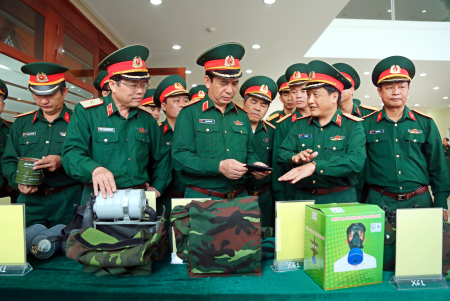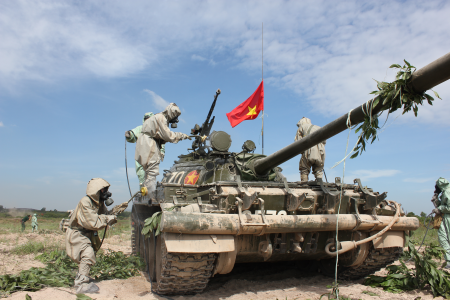Chemical Corps upholds the tradition of “Effective in protection – Capable in combat” in the cause of Homeland construction and defence.
Due to imperative demands resulted from the resistance war against the U.S. Imperialism, on April 19, 1958, Chemical – Nuclear Division, the predecessor of Chemical Corps, was established and put under the authority of the Combat Training Department. At that time, the division had to simultaneously build its structural organization and participate in combat missions, fulfilling its duty as the main detachment responsible for chemical protection for the armed forces and the civilians. With the spirit of “all for the frontline, all for the ultimate victory over the U.S. invaders”, chemical troops were sent to all battlefields to instruct soldiers and civilians to effectively protect themselves from the enemy’s chemical weapons; and cooperate with military units in using specialized weapons and equipment in combat, contributing to the cause of national reunification, and establishing the glorious tradition of Chemical Corps: “Effective in protection – Capable in combat”.
With this tradition, in the era of building and protecting the Motherland, Chemical Corps continues to play the main role in decontaminating and solving the consequences of chemical agents that still remain after the war. In recent years, chemical troops at all levels have investigated, collected and neutralized nearly 253 tons of CS, over 200 tons of CS-contained ordnance, thousands of cubic meters of CS and dioxin contaminated soil, etc, throughout the country, revitalizing many “dead lands”. The corps also took part in dealing with chemical incidents and environmental pollution, actively contributing to the socio-economic development of the country.
 |
| Sr. Lt. Gen. Phan Van Giang, Chief of the General Staff checking chemical protection equipment |
Today, the military in general, Chemical Corps in particular, is facing many challenging tasks in the cause of military building and Homeland protection. Notably, the tremendous amount of chemical and radioactive remnant left behind by U.S. military are still scattered in many locations, this problem requires complex solution and a lot of resources to solve. However, Chemical Corps’ manpower and equipment are still limited. Therefore, to successfully accomplish the assigned tasks, Chemical Corps Command has implemented a number of measures; the corps’ tradition must be constantly upheld, officers and soldiers of the corps must always stay motivated, united and committed to build a comprehensively robust Chemical Corps and successfully fulfill any task.
First, Chemical Corps Command and Party Committee recognized that military and national defense principles and strategies of the Party, especially 12th National Congress Resolution and 10th Military National Congress Resolution, etc, must be fully grasped and studied to provide effective counsel for Central Military Commission and Ministry of National Defense in chemical protection domain; building chemical protection resources and managing and controlling chemical and radioactive incidents. Accordingly, the corps must proactively study and evaluate weapon of mass destruction (WMD) programs in the region and all over the world, as well as threats of chemical, radioactive, nuclear incidents, environmental disasters, and especially the risk of radioactive contamination spread from the current development of nuclear power in the region. This evaluation served as the basis to advise Central Military Commission and Ministry of National Defense in developing strategies to deploy chemical protection contingents throughout the country, especially in strategic locations, to support potential combat operations and natural and environmental disaster relief activities. At the same time, Chemical Corps assisted the Party, the State and Minister of National Defense in drafting and complementing legal documents related to chemical protection domain, for example: Chemical Substances Law, Nuclear Power Law; and many decrees and orders of the Government and Ministry of National Defense on chemical incident management and control, etc. These activities have greatly contributed to toxic chemical substance and Agent Orange decontamination programs and projects in the country. In the coming years, the corps will continue to advise superior authorities in the implementation of WMD non-proliferation treaties and mechanisms to enhance peace and stability for the development of the country.
In addition, Chemical Corps carried out structural reorganization and enhancement in its subordinate units in accordance to the structural organization of the military in the new situation, especially Nuclear – Radioactive – Chemical Incident Response Center and Environmental Disaster Relief Team. Administrative detachments and chemical support contingents were enhanced organizationally to improve their combat effectiveness and mobility, appropriate to current missions and equipment, and strengthen their capability in chemical and radioactive incident management, control and protection. With “Chemical protection equipment plan by 2020 and later years”, Chemical Corps has paid special attention to the study and development of chemical warfare tactics in a variety of scenarios, especially in naval and island combat, counter terrorist operations, and Nuclear – Biological – Chemical Incident Relief activities, etc.
Chemical Corps is the specialized arm that regularly has to conduct highly hazardous operations. So that the corps always put a lot of efforts in developing its human capital, seeking to enhance political awareness, determination, and professional expertise for its members. To that end, cadres and specialists were trained and tutored to improve their professional skills and command – staff abilities in combined arms operations, and bolster their understanding in chemistry and nuclear domain, and NBC incident relief and decontamination. Notably, they were also trained to adapt and employ scientific advancements of the 4th Industrial Revolution in WMD protection.
 |
| Practicing chemical protection for weapons and hehicles |
At the same time, Chemical Corps placed emphasize on improving training quality and combat readiness, considering these as crucial factors in enhancing its overall strength and combat capability. Hence, the corps instructed its subordinate units to push ahead the implementation of Central Military Commission Resolution 765 – NQ/QUTW on the renovation of training methods, management, organization and leadership. To that end, training programs focusing on leadership ability and incident response techniques were applied to officers and specialists, especially those who directly involve in dealing with chemical, radioactive and nuclear accidents or in charge of training for highly specialized contingents. The main goals of these programs are to ensure that those officers and specialist would really become primary elements in resolving potential incidents domestically, also capable of participating in regional and international missions. These training programs also focused on practical activities to improve chemical troops’ mobility and combat capability in all terrains, under all weather conditions and against potential enemies that have technological superiority, etc.
Chemical Corps’s missions are always very demanding, and require rapid response and serious efforts. So that the corps constantly maintains combat readiness regime; instruct its subordinate detachments to frequently review and adjust their combat plans and regularly conduct drills. Over the past years, Chemical Corps has carried out hundreds of drills at all level; at the same time, it also actively participated in combined arms exercises with other services and specialized arms. In these drills, participants from the corps always successfully completed all given tasks and made positive impression to other friendly units. To further enhancing its chemical protection capability, Chemical Corps pushed ahead many science projects of its own. Since 2007, the corps has conducted many research programs which were highly acclaimed and applied in training, combat readiness activities, and chemical decontamination operations. Besides, the corps increasingly involved in international cooperation activities, such as fund raising events for chemical protection equipment acquisition and decontamination operations, or technology transfer programs, etc. During the past few years, it has also worked with many partners like Cape Thermonyde (U.S.) and Shimizu (Japane) in dioxin decontamination operations. At the same time, several cadres of the corps have been sent to other countries to examine chemical protection technologies or training methods and models, participate in drills, and discuss on possible cooperation activities with foreign partners. In the near future, Chemical Corps will continue to coordinate with American partners in building capabilities for chemical, biological, radioactive, and nuclear accident response under the framework of the Agreement No. 1139/VP-DN, which was signed by both parties on January 29, 2018. These cooperation activities will surely enhance the corps’ chemical protection capability to fulfill any requirements of our national defense and economic development tasks.
Officers and soldiers of Chemical Corps, with the glorious tradition and accomplishments achieved over the past 60 years, will surely continue to commit to their tasks and actively overcome any challenges to play their part in preserving peace and stability for the cause of building and protecting the Motherland in the new era.
Major General Ha Van Cu, Chemical Corps Commander